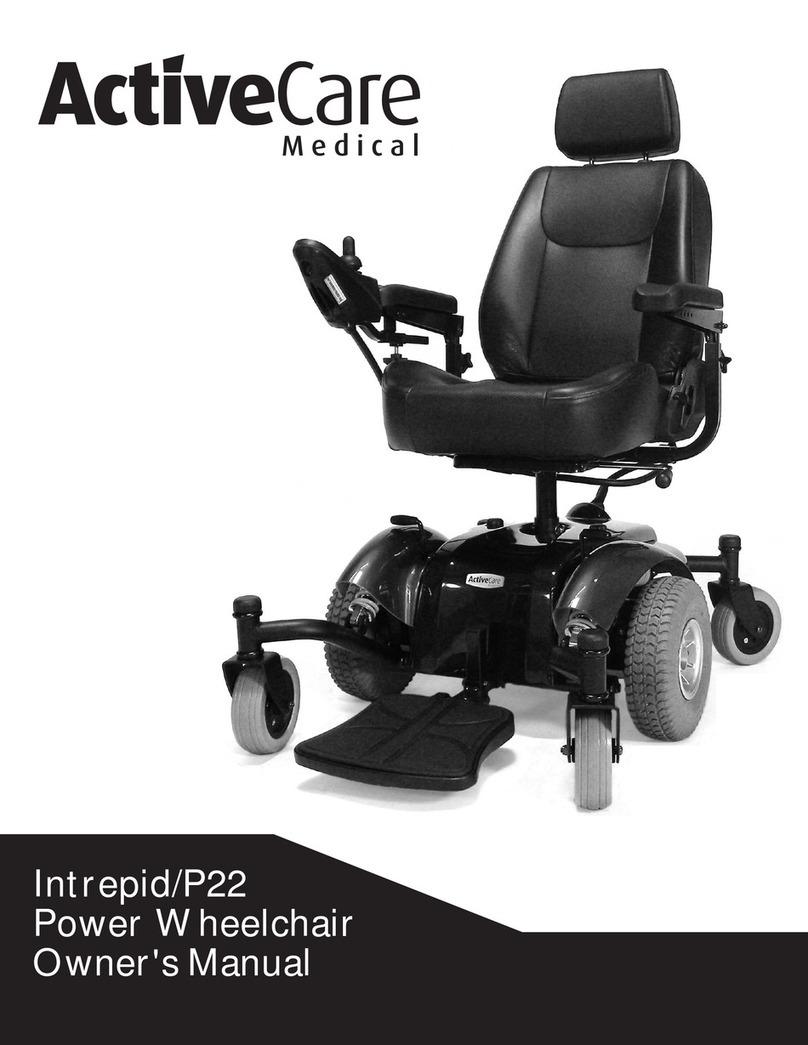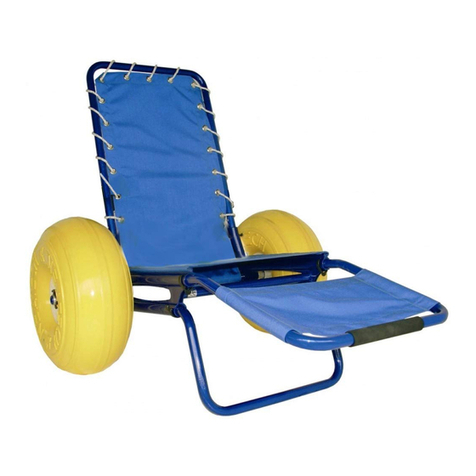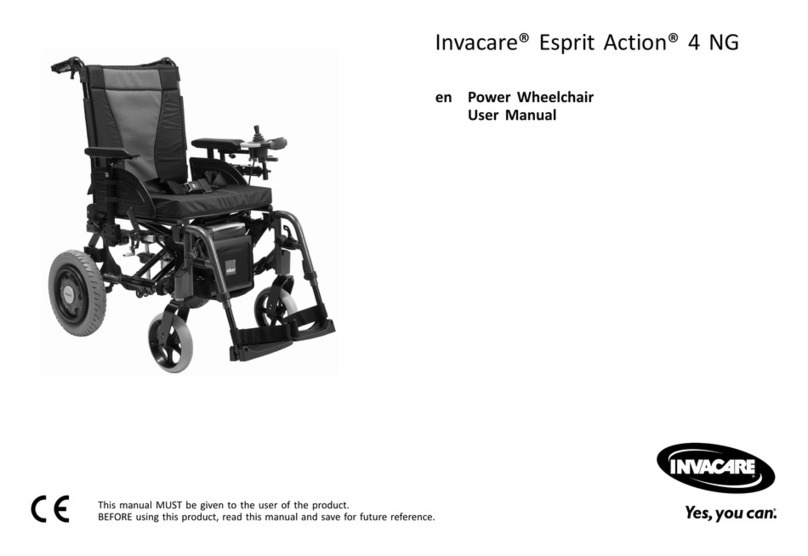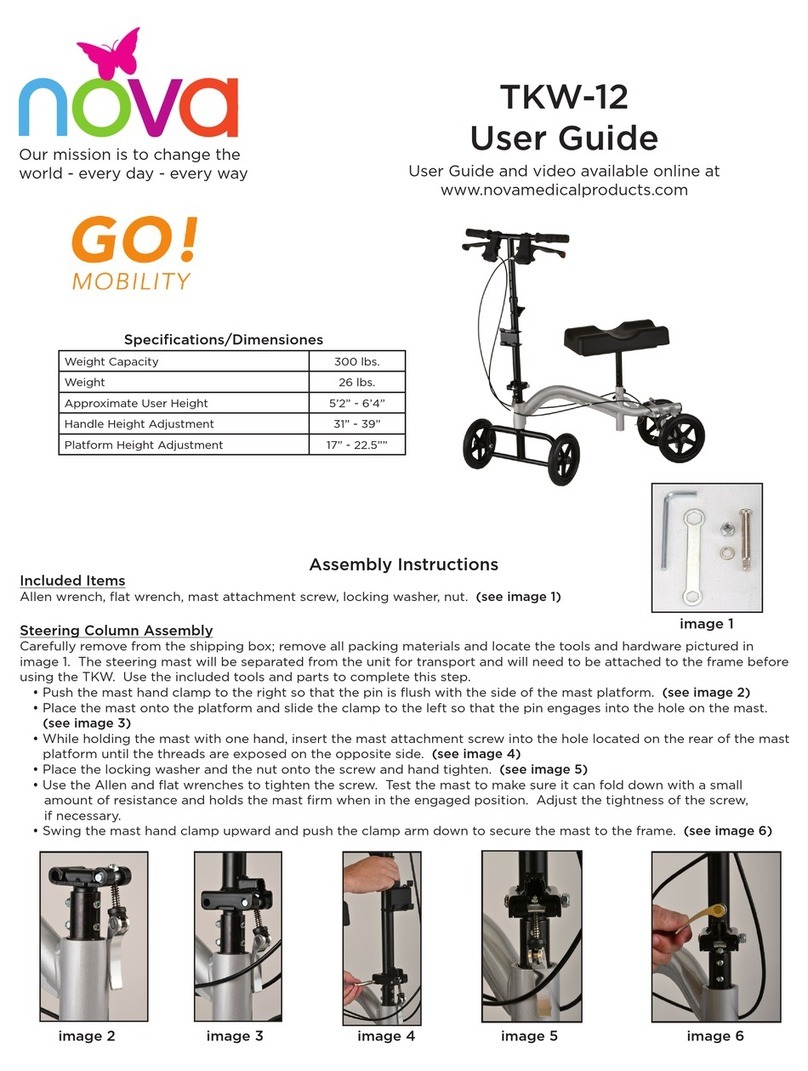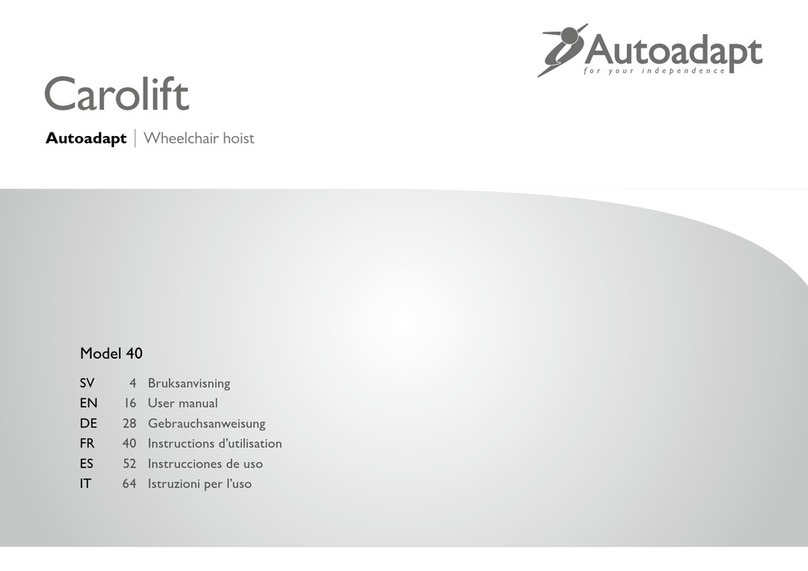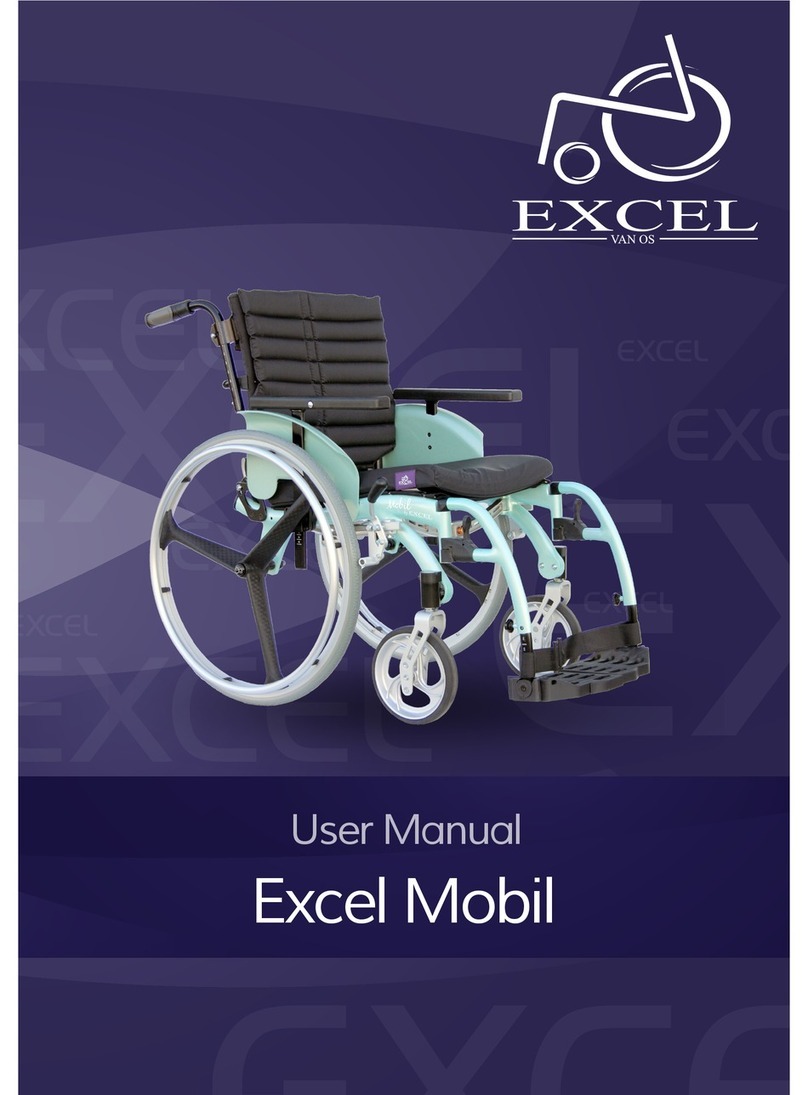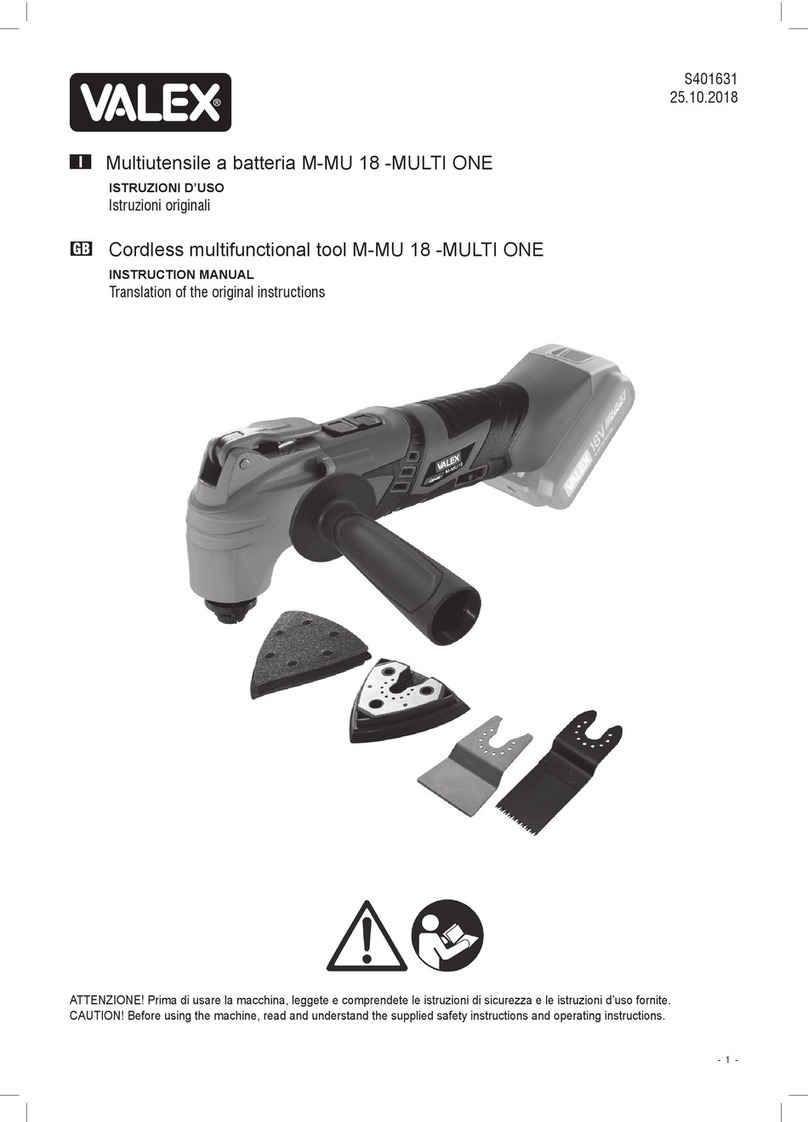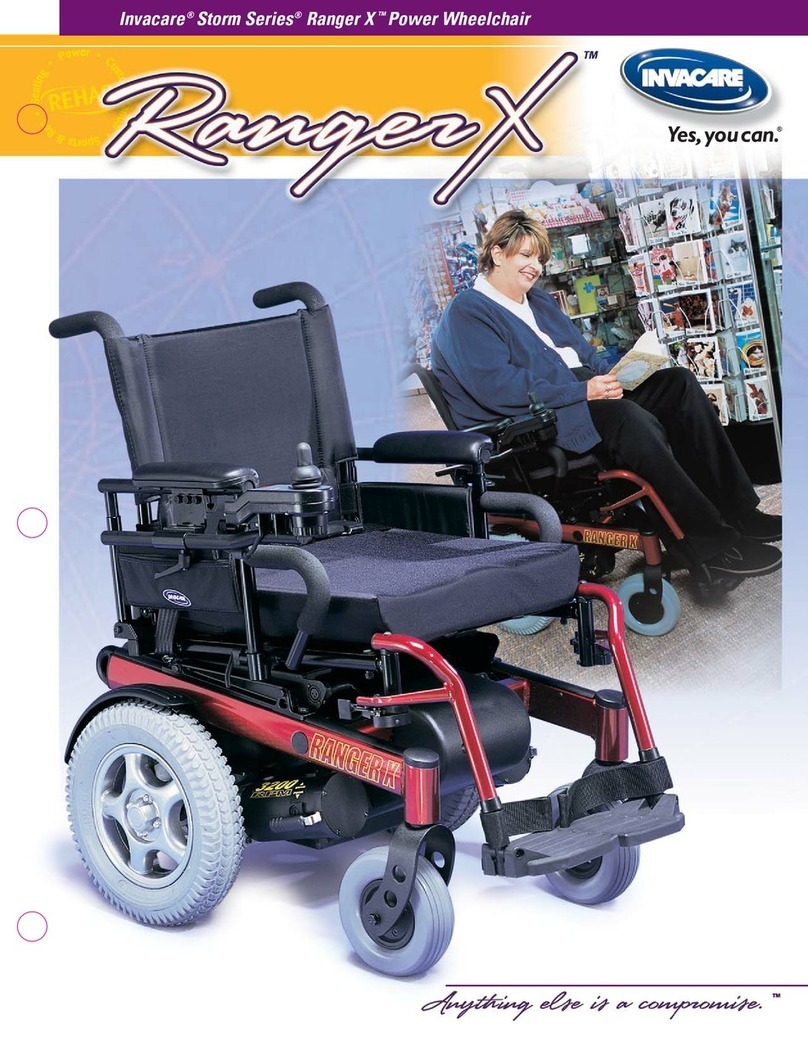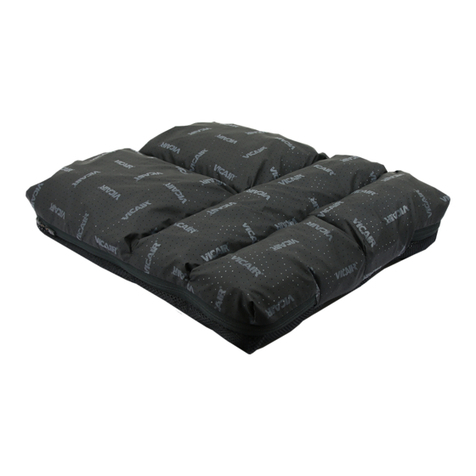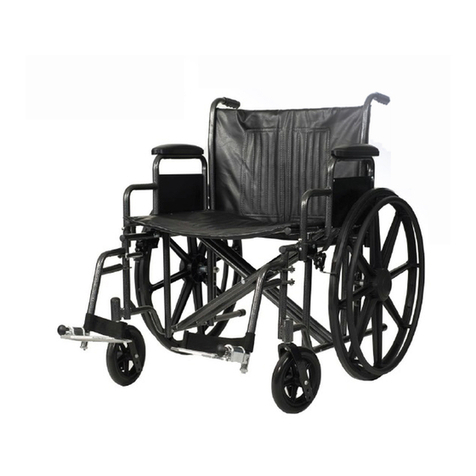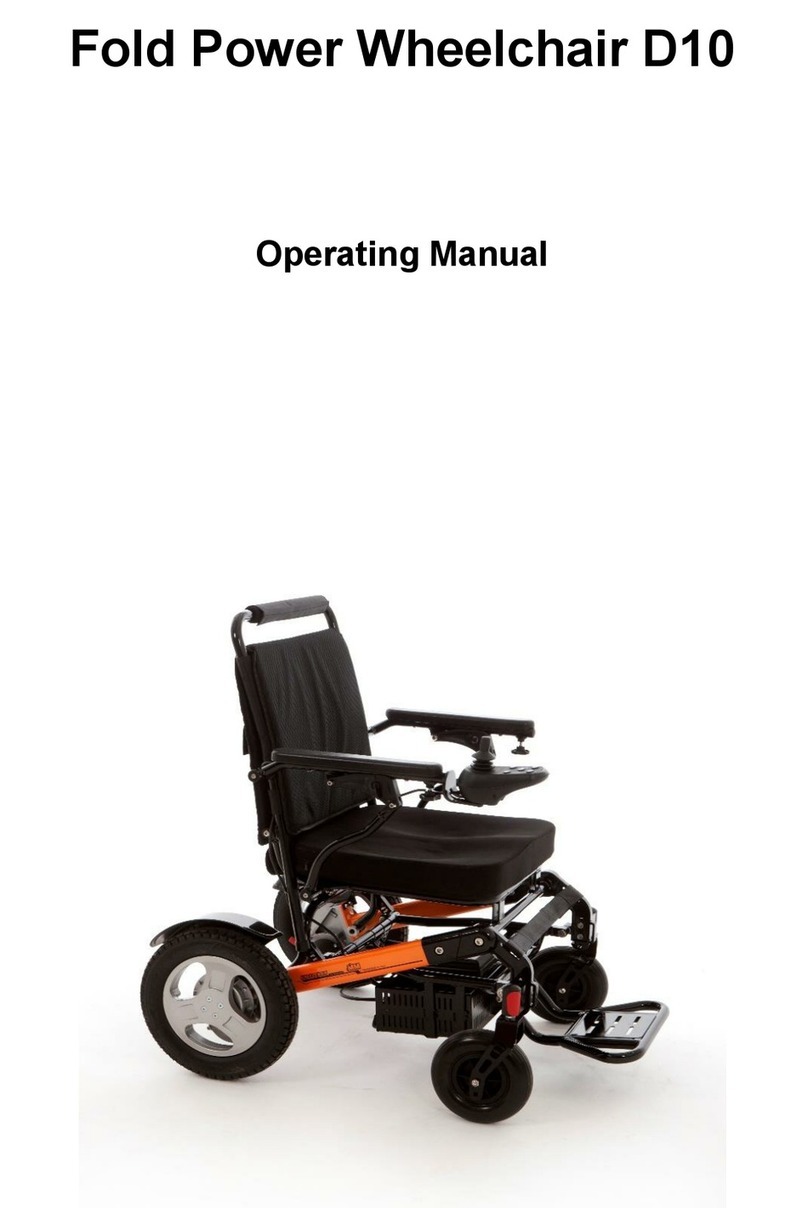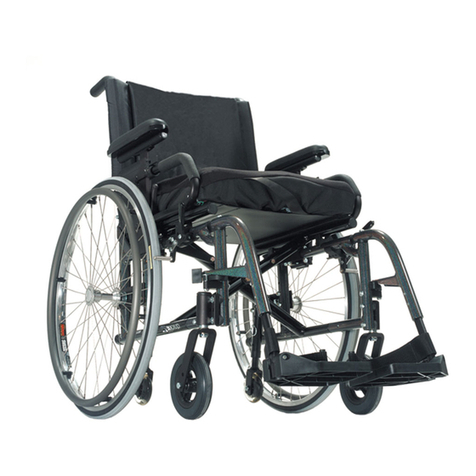Active Care Medical Intrepid User manual

Intrepid
Power Wheelchair
Owner's Manual
TM


For service assistance, please call your authorized ActiveCare dealer.
Intrepid Owner’s Manual 1
Table of Contents
1. Preface...............................................................................................................................2
2. Safety Notices...................................................................................................................3
3. EMI.....................................................................................................................................4
Electromagnetic Interference (EMI) From Radio Wave Sources........................................4
Powered Wheelchair Electromagnetic Interference (EMI)..................................................5
4. Parts...................................................................................................................................6
5. Assembly...........................................................................................................................7
6. Operation.........................................................................................................................10
General Information..........................................................................................................10
Controller..........................................................................................................................10
Freewheel Mode...............................................................................................................11
Security Functions............................................................................................................11
Transporting Your Chair....................................................................................................11
Positioning Belts...............................................................................................................12
Use on Inclines.................................................................................................................12
7. Batteries & Charging......................................................................................................15
Charger Specifications ....................................................................................................15
Charger Features............................................................................................................16
Charger Operation Instructions .......................................................................................16
Charger Usage Environment...........................................................................................16
Notes...............................................................................................................................16
8. Inspection & Maintenance .............................................................................................17
Battery..............................................................................................................................17
Motor................................................................................................................................17
Electrical Brakes ..............................................................................................................17
Tires .................................................................................................................................17
9. Troubleshooting..............................................................................................................18
10. Specifications .................................................................................................................19
11. Limited Warranty ............................................................................................................20
Product Registration.........................................................................................................21

For service assistance, please call your authorized ActiveCare dealer.
2 Intrepid Owner’s Manual
Preface
NOTICE!
An authorized ActiveCare Provider or a qualified technician must perform the initial setup of
this power chair and must perform all of the procedures in this manual.
This owner’s manual includes operation instructions for every aspect of the power wheelchair,
assembly instructions, as well as instructions for how to deal with possible accidents. Read
and follow all instructions, warnings, and notes in this manual before attempting to operate
your power chair for the first time. You must also read all instructions, warnings, and notes
contained in any supplemental instructions that accompanied your power chair before initial
operation.
If you do not understand any information contained in this manual, or if you require additional
assistance for setup or operation, please contact your authorized ActiveCare Provider. Failure
to follow the instructions in this manual and those located on your power chair can lead to
personal injury and/or damage to the power chair, and may void the warranty.
The symbols used in this manual are explained below. Read carefully, especially the parts
marked with these symbols:
Warning Improper usage could lead to death or serious injury
◊Caution Improper usage could lead to injury and/or damage to your
power wheelchair.
Suggestion Follow these instructions to keep the status of the power
wheelchair working well and ease your operation.
This manual includes the repair and maintenance record chart and warranty. Please keep it in
a proper place or on the wheelchair. If someone else uses the wheelchair, please be sure to
give the instruction manual to him or her.
As designs change, some illustrations and pictures in the manual may not correspond to the
product that you purchased. We reserve the right to make design modifications.
The manufacturer disclaims all responsibilities for any personal injury or property damage
which may occur as a result of improper or unsafe use of its products.

For service assistance, please call your authorized ActiveCare dealer.
Intrepid Owner’s Manual 3
Safety Notices
1. Always fully charge your power chair before operating.
2. Always make sure the power is off when getting in and out of the power chair.
3. Always make sure the clutch levers are engaged (parallel to the wheels) before getting in
or out the wheelchair.
4. To prolong the life of the battery, it is suggested you charge the battery after every trip. If
you do not drive it for long periods of time, charge it at least once per month.
5. If the battery gauge goes to RED, charge the battery as soon as possible. If the battery is
totally discharged, it could be damaged, and/or its life could be shortened.
6. As the battery ages and deteriorates, the battery power will decrease faster.
7. In cold weather, the battery capacity will be less.
8. When you are charging the battery, please make sure that the input-voltage (115V/230V)
switch on your charger matches your power source.
9. Avoid unnecessarily moving of the power chair.
10. Please fasten the seat belt, if included, while driving and check the proper position of the
anti-tip wheel.
11. Our products function best at temperatures between 32-122oFahrenheit.
12. Disassembling of controller, motor or charger by end user is prohibited; the dealer will not
take any responsibility on these kinds of situations.
13. Prevent the controller, charger and battery from getting wet; this can cause a malfunction.
14. To ensure the user’s familiarity with the power chair’s operation, the new driver should
practice driving in a spacious area, traveling forward, backward, left, right, using the
brakes, and going both up and down slopes.
15. Please turn off the power chair when the chair is not is use and before charging the
battery.
16. The following areas and conditions can be dangerous and should be avoided; darkness,
dim lighting, steep slopes, rain, snow, shoulder of the road, slippery areas, etc.
17. Please do not drive your power chair at night without proper lighting.
18. Please do not lower the footplate to less than 2” above the ground, because accidents
may occur due to insufficient ground clearance.
19. Keep your feet on the footplate at all times during operation and do not stand on the
footplate. If your feet are in the improper position, you can be seriously injured.
20. When the power does not come on, recheck all connections and recharge if necessary.
21. Please check the screws under the joystick periodically and make sure they are not loose,
and tighten them if needed.

For service assistance, please call your authorized ActiveCare dealer.
4 Intrepid Owner’s Manual
Eletromagnetic Interference (EMI)
This portion of the manual will provide the user with basic information about the problems with
EMI (electromagnetic interference), protective measures can be used to either lessen the
possibility of exposure or to minimize the degree of exposure; this section also shows some
conditions that unexpected or erratic movements may cause.
◊ Caution
It is very important that you read this information regarding the possible effects
of electromagnetic interference on your electric ActiveCare power wheelchair.
ELECTROMAGNETIC INTERFERENCE (EMI) FROM RADIO WAVE
SOURCES
Power wheelchairs may be susceptible to electromagnetic interference (EMI), which is
interfering electromagnetic energy (EM) emitted from sources such as radio stations, TV
stations, amateur radio (HAM) transmitters, two-way radios, and cellular phones. The
interference (from radio wave sources) can cause the power wheelchair to release its brakes,
move by itself, or move in unintended directions. It can also permanently damage the power
wheelchair’s control system. The intensity of the interfering EM energy can be measured in
volts per meter (V/m). Each power wheelchair can resist EMI up to a certain intensity level.
The higher the immunity level the greater the protection. At this time, current technology is
capable of achieving at least a 20 V/m immunity level, which would provide useful protection
from the more common sources of radiated EMI. This power wheelchair model as shipped,
with no further modification, has an immunity level of 20 V/m without any accessories.
There are a number of sources of relatively intense electromagnetic fields in the everyday
environment. Some of these sources are obvious and easy to avoid. Others are not apparent
and exposure is unavoidable. However, we believe that by following the warning listed below,
your risk to EMI will be minimized.
The sources of radiated EMI can be broadly classified into three types:
1. Hand-held portable transceivers (transmitter-receivers with the antenna mounted directly
on the transmitting unit). Examples include: citizens band (CB) or hand held radios,
(security, fire, and police transceivers), cellular telephones and other personal
communication devices.
NOTE: Some cellular telephones transmit a signal while they are ON but not being used.
2. Medium-range mobile transceivers, such as those used in police cars, fire trucks,
ambulances and taxis usually have the antenna mounted on the outside of the
wheelchair.

For service assistance, please call your authorized ActiveCare dealer.
Intrepid Owner’s Manual 5
3. Long-range transmitters and transceivers, such as commercial broadcast transmitters
(radio and TV broadcast antenna towers) and amateur (HAM) radios.
NOTE: Other types of hand-held devices, such as cordless phones, laptop computers, AM/FM
radios, TV sets, CD player, and cassette players, and small appliances, such as electric
shavers and hair dryers, are not likely to cause EMI problems to your power wheelchair.
POWER WHEELCHAIR ELECTROMAGNETIC INTERFERENCE (EMI)
EM energy rapidly becomes more intense as one moves closer to a transmitting antenna
(source). The EM fields from hand-held radio wave sources (transceivers) are of special
concern. It is possible to unintentionally bring high levels of EM energy very close to the power
wheelchair’s control system while using these devices; this can affect your wheelchair’s
movement and braking. Therefore, the warnings listed below are recommended to prevent
possible interference with the control system of a power wheelchair.
Warning!
Electromagnetic interference (EMI) from sources such as radio and TV
stations, amateur radio (HAM) transmitters, two-way radios, and cellular
phones can affect power wheelchairs. Following the warnings listed below
should reduce the chance of unintended brake release or power wheelchair
movement which could result in serious injuries.
1. Do not operate hand-held transceivers-receivers, such as citizens band
(CB) radios, or turn ON personal communication devices, such as cellular
phones, while the power wheelchair is turned ON.
2. Be aware of nearby transmitters, such as radio or TV stations, and try to
avoid getting close to them.
3. If unintended movement or brake release occurs, turn the power wheelchair
OFF as soon as it is safe.
4. Be aware that adding accessories or components, or modifying the power
wheelchair, may make it more susceptible to EMI.
5. Report all incidents of unintended movement or brake release to
ActiveCare Medical, and note whether there were sources of EMI nearby.

For service assistance, please call your authorized ActiveCare dealer.
6 Intrepid Owner’s Manual
Parts
INTREPID
1. Headrest
2. Joystick
3. Controller
4. Seat
5. Front Caster
6. Footplate
7. Backrest
8. Armrest
9. Shroud
10. Rear Caster
11. Drive Wheel
12. Rear Bag
13. Main Cable
1
2 7
3 8
4
9
5 10
6 11
12
13

For service assistance, please call your authorized ActiveCare dealer.
Intrepid Owner’s Manual 7
Assembly
1. Loosen and remove the two knobs located
on the cover shroud on either side of the seat
post.
2. Carefully remove the shroud.
3. There are four connectors from main cable.
Two black and red connectors are for batteries;
two white connectors are for the motor.
Connect both battery connectors with the main
cable, black to black, red to red.

For service assistance, please call your authorized ActiveCare dealer.
8 Intrepid Owner’s Manual
4. Carefully place the shroud with the seat post
and clutch levers fitting through their
appropriate openings. Lock the shroud in place
with the two knobs removed in Step 1.
5. Lift the seat and pull the swivel lever up at
the same time. Slide the bottom of the seat
onto the seat post. Swivel the seat and push
down on the seat until it locks in place.
6. Connect the main cable to the connection
port at the back of the cover shroud.

For service assistance, please call your authorized ActiveCare dealer.
Intrepid Owner’s Manual 9
7. Take the controller and insert its square tube
into the tube under the armrest. Tighten the bolt
on the underside of the controller arm tube to
hold it in place.
8. Fully charge the wheelchair’s batteries by
inserting the round charger connector into the
battery charging terminal on the front of the
wheelchair’s controller and inserting the
3-pronged plug into a standard electrical outlet.
Ensure that the 115V/230V switch on the
product’s battery charger is set to 115V. If the
switch is set to 230V, the batteries will not
charge properly.
Full charging normally takes 6-8 hours, but can
take as many as 10 hours depending on the
batteries’ charge level when starting and the
ambient temperature.
115V/230V switch
Product Disassembly
To disassemble your power wheelchair, reverse the preceding procedure, beginning
with Step 7.

For service assistance, please call your authorized ActiveCare dealer.
10 Intrepid Owner’s Manual
Operation
GENERAL INFORMATION
1. Make sure that the motor levers are in engaged mode. (Parallel to the wheels)
2. Once seated on the wheelchair, turn on the power (Press the power button). The battery
gauge will turn on.
3. We suggest the new users and the disabled operate the chair in low speed until
comfortable with the chair and its use.
4. Start to steer, moving the joystick to drive forward, backward, left or right. If you want to
stop the wheelchair, release the joystick—it will automatically return to the center position
to stop the chair.
5. The chair’s speed is automatically reduced by half when the chair is turning.
6. When driving the chair on a slope, push the joystick forward to keep the chair
continuously climbing until you reach the top of the slope. While the chair is climbing a
steep slope, position your body forward to prevent the front wheels from lifting.
7. When driving the chair down a slope, drive slowly and prepare for an emergency stop if
you feel it difficult to control the chair. If the speed increases, release the joystick to slow
down or to stop, then start again at a slower speed.
CONTROLLER
Battery Gauge
Speed Up Button
Joystick
Service Indicator
Speed Down Button
Power On/Off
Buzzer Button
Battery Gauge
When the power chair is turned on, the battery gauge will light up as indicated below:
Green lights: the battery has full capacity.
Orange lights: do not drive power-chair for a long trip.
Red lights: the power-chair should be charged as soon as possible.

For service assistance, please call your authorized ActiveCare dealer.
Intrepid Owner’s Manual 11
FREEWHEEL MODE
The Catalina Power Wheelchair is equipped with two freewheel levers. These levers allow you
to disengage the drive motors and maneuver the chair manually.
Warning!
DO NOT use your wheelchair while the drive motors are disengaged unless
someone is there to push you. The chair could roll on its own causing injury!
To engage or disengage the freewheel feature:
1. Turn the freewheel levers outward to disengage the drive motors.
2. Turn the freewheel levers inward, to engage the drive motors.
◊ Caution
It is important to remember that when your Catalina Power Wheelchair is in
freewheel mode, the braking system is disengaged.
SECURITY FUNCTIONS
1. The forward/backward/turn speed, acceleration and deceleration are programmable.
2. Thermal overload protection.
3. Current overload protection.
4. The fault diagnostics of the controller (see “Troubleshooting” section).
5. The power-chair will not operate while charging the batteries.
TRANSPORTING YOUR CHAIR
If you will be traveling with your power chair, you may find it necessary to use a lift/elevation
product or portable ramp to aid in transportation. ActiveCare suggests you closely review the
instructions, specifications, and safety information included with the lift/elevation product
before using that product.
Warning!
Never sit on your power chair when it is being used in connection with any type
of lift/elevation product or portable ramp. Your power chair was not designed
with such use in mind and any damage or injury incurred from such use is not
the responsibility of ActiveCare.
ActiveCare recommends that you do not remain seated in your power chair while traveling in a
motor vehicle. The power chair should be stowed in the trunk of a car or in the back of a truck
or van with batteries removed and properly secured.

For service assistance, please call your authorized ActiveCare dealer.
12 Intrepid Owner’s Manual
Warning!
Do not sit on your power chair while it is in a moving vehicle.
Warning!
Always be sure your power chair and its batteries are properly secured when it
is being transported. Batteries should be secured in an upright position and
protective caps should be installed on the battery terminals. Batteries should
not be transported with any flammable or combustible items.
POSITIONING BELTS
Your authorized ActiveCare Provider, therapist(s), and other healthcare professionals are
responsible for determining your requirement for a positioning belt in order to operate your
power chair safely.
Warning!
If you require a positioning belt to safely operate your power chair, make sure it
is fastened securely in order to reduce the possibility of a fall from your power
chair.
Warning!
The positioning belt is not designed for use as a seat belt in a motor vehicle.
Nor is your power chair suitable for use as a seat in any vehicle. Anyone
traveling in a vehicle should be properly belted into seats approved by the
vehicle manufacturer.
USE ON INCLINES
Many buildings have wheelchair-accessible ramps with specified degrees of incline, designed
for easy and safe access. Some ramps may have turning switchbacks (180-degree turns) that
require you to have good cornering skills on your power chair.
Proceed with extreme caution as you approach the downgrade of a ramp or other incline.
DO NOT use on inclines greater than 12°.
Take wide swings with your power chair’s front wheels around any tight corners. If you do that,
the power chair’s rear wheels will follow a wide arc, not cut the corner short, and not bump into
or get hung up on any railing corners.
When driving down a ramp, keep the power chair’s speed adjustment set to the slowest speed
setting to ensure a safely controlled descent.
Avoid sudden stops and starts.

For service assistance, please call your authorized ActiveCare dealer.
Intrepid Owner’s Manual 13
When climbing an incline, try to keep your power chair moving. If you must stop, start up again
slowly and then accelerate cautiously. When driving down an incline, set your power chair to
the slowest speed setting and drive in the forward direction only. If your power chair starts to
move down the incline faster than you anticipated or desired, allow it to come to a complete
stop by releasing the joystick, then push the joystick forward slightly to ensure a safely
controlled descent.
Warning!
When on any sort of an incline or decline, never place the power chair in
freewheel mode while seated on it or standing next to it.
Warning!
When climbing an incline, do not zigzag or drive at an angle up the face of the
incline. Drive your power chair straight up the incline. This greatly reduces the
possibility of a tip or a fall. Always exercise extreme caution when negotiating
an incline.
Warning!
You should not travel up or down a potentially hazardous incline (i.e., areas
covered with snow, ice, cut grass, or wet leaves).
Warning!
If your power chair is equipped with a reclining seatback, do not attempt to
negotiate inclines with the seat in a reclined position. Do not attempt to
negotiate obstacles with the seat in a reclined position unless an attendant is
present to help stabilize the chair. Failure to heed could result in the power
chair tipping over.
Warning!
Never travel down an incline backward. Doing so may cause the power chair to
tip. Always exercise extreme caution when negotiating an incline.
Excessively high cornering speeds can create the possibility of tipping. Factors which affect
the possibility of tipping include, but are not limited to: cornering speed, steering angle (how
sharply you are turning), uneven road surfaces, inclined road surfaces, riding from an area of
low traction to an area of high traction (such as passing from a grassy area to a paved area –
especially at high speed while turning), and abrupt directional changes. High cornering speeds
are not recommended. If you feel that you may tip over in a corner, reduce your speed and
steering angle (i.e., lessen the sharpness of the turn) to prevent your power chair from tipping.

For service assistance, please call your authorized ActiveCare dealer.
14 Intrepid Owner’s Manual
Warning!
When cornering sharply, reduce your speed and maintain a stable center of
gravity. This greatly reduces the possibility of a tip or fall.

For service assistance, please call your authorized ActiveCare dealer.
Batteries & Charging
Before using your power mobility product for the first time, you will need to charge your
batteries for 8 – 10 hours to ensure that they are fully charged.
Suggestion
ActiveCare Medical recommends that frequent users of their power mobility
products charge their batteries overnight, 8 – 10 hours, to make certain they
have a full charge each day.
Suggestion
ActiveCare Medical recommends that infrequent users of their power mobility
product charge their batteries once a week for 8 – 10 hours.
ActiveCare Medical’s battery chargers, specific to our product, are designed to not overcharge
the batteries. You may leave your power mobility product plugged into the charger for longer
than 8 – 10 hours without causing damage to the batteries.
In some instances ActiveCare Medical’s battery charger may show two green lights indicating
that the batteries are fully charged—this is not always the case. A good rule of thumb is to
charge your batteries 8 – 10 hours before each use to ensure that your power mobility product
has a full charge.
CHARGER SPECIFICATIONS
Input Voltage 115V/230V Option Switch
115V(95V-132V)/230V(180V-264V)
Output Voltage 24V
Output Current 3A-6A Continuous
Maximum Output Voltage 31V
Protection Against Over-Voltage Above 32.5V:Automatic Shut-off
Protection Against Overload Above 8A:Automatic Shut-off
Protection Against Short Circuit Output Fuse Shuts-off Automatically
Environmental Temperature of Use -10° to 50°
Environmental Temperature of Preservation -25° to 85°
Dimensions 7” (L) x 3.7” (W) x 2” (H)
Weight 1.83 lbs.
Intrepid Owner’s Manual 15

For service assistance, please call your authorized ActiveCare dealer.
16 Intrepid Owner’s Manual
CHARGER FEATURES
1. Ensures the battery connection automatically.
2. Monitoring all procedures until the battery is fully charged.
3. For protecting exhausted batteries, slow charge starts in the beginning then fast charge
until it goes up to the normal voltage.
4. Compact, portable and light-weight.
5. Approvals: UL, CSA, CE, TUV, JAPAN (T-mark)
CHARGER OPERATION INSTRUCTIONS
Please follow these steps:
1. Select the correct input voltage (115/230V) on the 115/230V option switch.
2. Assure charging on lead-acid batteries only.
3. Keep the AC power switch off until the battery and charger have been connected.
4. Make sure the output end of the charger corresponds with the positive/negative pole of
battery.
5. Turn on the AC power switch to “I” (the fan should begin to run). When LED turns to
red/yellow, it means the charger has been under normal charging condition.
6. When LED turns to red/green, it means the battery has been fully charged. The charging
procedure has completed.
7. While the yellow/green LED is lit, it may have a temporary alternating occurrence around
1-60 seconds during switching. Please note that this is normal.
CHARGER USAGE ENVIRONMENT
1. Please keep the charger at least 2 inches away from other objects when charging.
2. Do not use it on wet and dirty surfaces.
3. Do not place the charger on the battery.
NOTES
1. Ensure the output-DC voltage corresponds to the battery type and voltage. Otherwise it
may cause an explosion.
2. Switch off the charger before connecting the charger and the battery.
3. Do not expose the charger to the rain, water or near flammable materials. Do not store
the charger in humid places or in a closed area.
4. The warranty is given for use within normal operating conditions; it does not cover
accidental damage, or problem caused by user’s neglect or misuse.

For service assistance, please call your authorized ActiveCare dealer.
Intrepid Owner’s Manual 17
Inspection & Maintenance
BATTERY
Please charge the batteries after long distance driving to prolong the battery. If you don’t drive
the chair for along period of time, then charge at least every month. Please use a
maintenance/water-free battery to avoid trouble.
MOTOR
The carbon brush connector & brakes should be replaced regularly.
ELECTRICAL BRAKES
Testing of the electrical brakes should be carried out on a level floor with at least three feet of
clearance space around the power chair.
Power-on the controller, and push the joystick forward slowly until you hear the electrical brake
working. The power wheelchair may start to move. Immediately release the joystick, you must
be able to hear each electrical brake within a few seconds. Repeat the test three times,
pushing the joystick backward, left and right respectively.
TIRES
Check front/rear tires regularly and replace them when worn out.
Suggestion
Tire wear is not covered under your power wheelchair’s warranty.

For service assistance, please call your authorized ActiveCare dealer.
18 Intrepid Owner’s Manual
Troubleshooting
The diagnostic flash codes for your power wheelchair are designed to help you perform basic
troubleshooting quickly and easily. A diagnostic flash code flashes from all 6 of the LED’s
located on the controller in the event one of the conditions listed below develops.
Table 1: Power Wheelchair Controller Internal Diagnostics
Flash
Code Description Recommended Action
1 Motor Current Over Limit Motor current is over the controller set limit.
Release the joystick to neutral and try again
2 Battery Try charging the batteries.
Batteries need replacing.
Check the battery cables and connections
3 Left Motor Check left motor cables and connections
4 Right Motor Check right motor cables and connections
5 Left Parking Brake Check left parking brake cables and connections
6 Right Parking Brake Check right parking brake cables and
connections
7 User Interface Display PCB fault. Consult a service agent.
8 Controller Consult a service agent.
9 A-series Bus
Communication Consult a service agent.
If more than one fault exists, the fault having the highest priority (and lowest number of
flashes) is indicated. All faults disable the controller and require the controller to be turned off
then on again once the source of the fault is removed.
Table of contents
Other Active Care Medical Wheelchair manuals
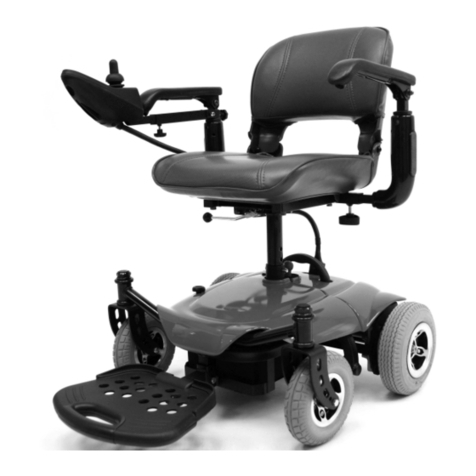
Active Care Medical
Active Care Medical Cobalt User manual
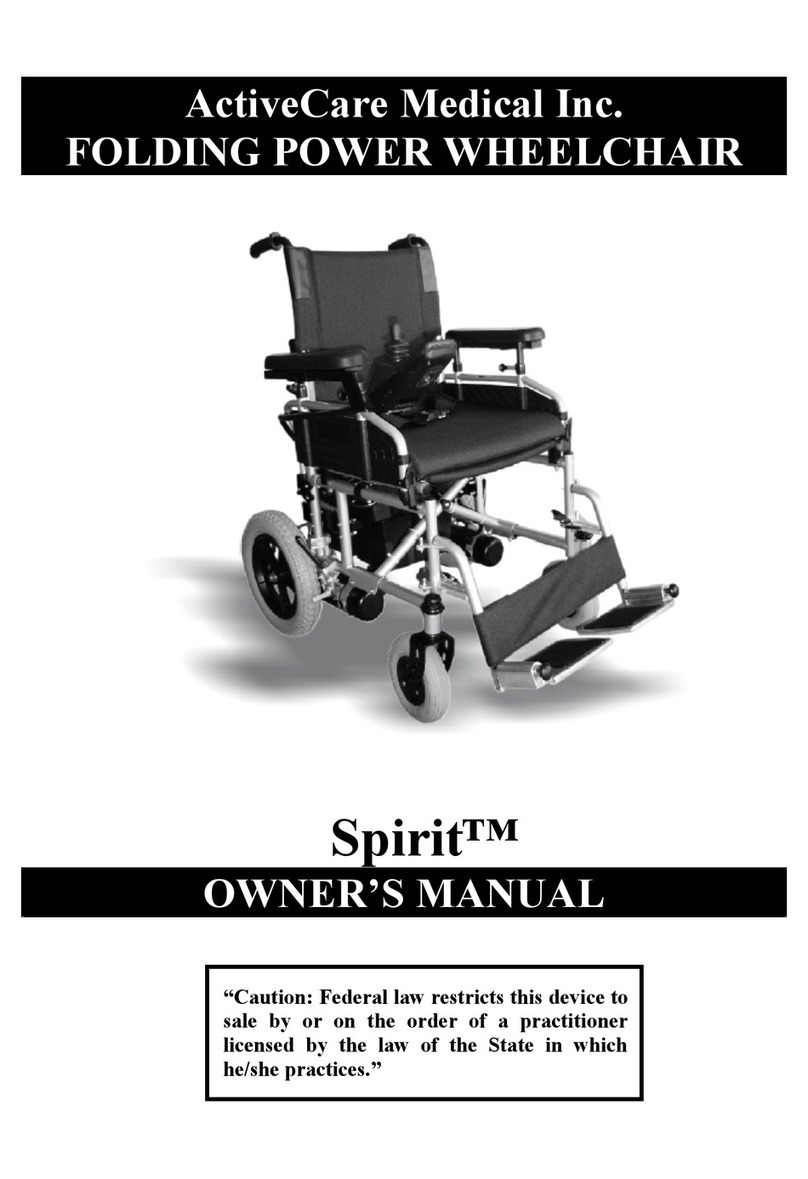
Active Care Medical
Active Care Medical Spirit User manual
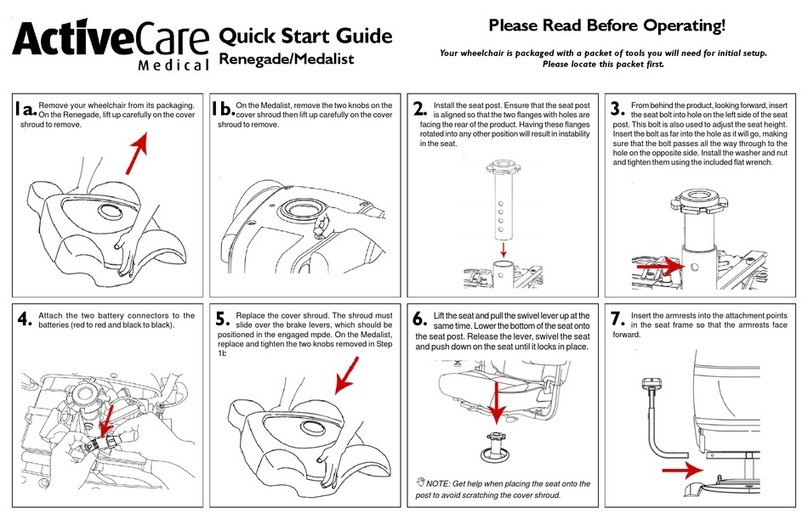
Active Care Medical
Active Care Medical Renegade User manual
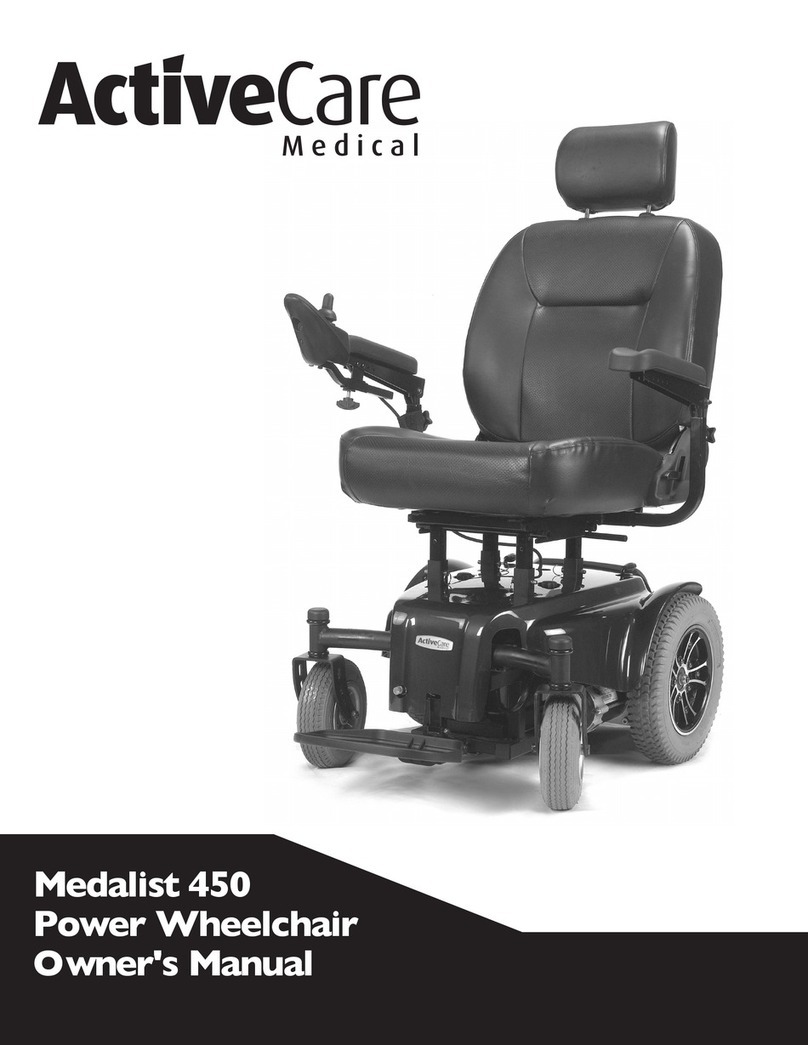
Active Care Medical
Active Care Medical Medalist 450 User manual
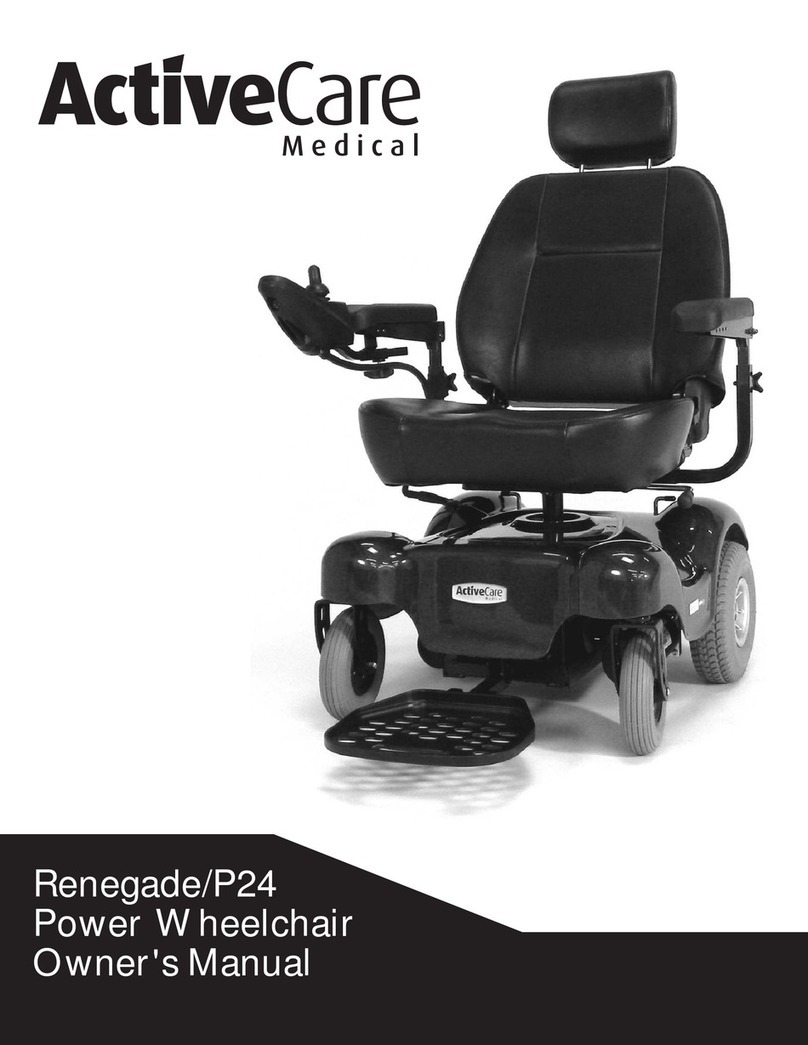
Active Care Medical
Active Care Medical Renegade/P24 User manual
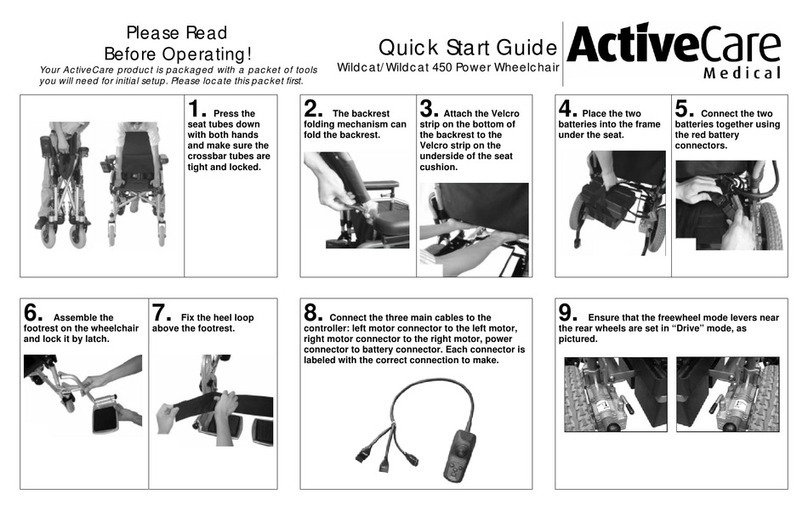
Active Care Medical
Active Care Medical Wildcat User manual
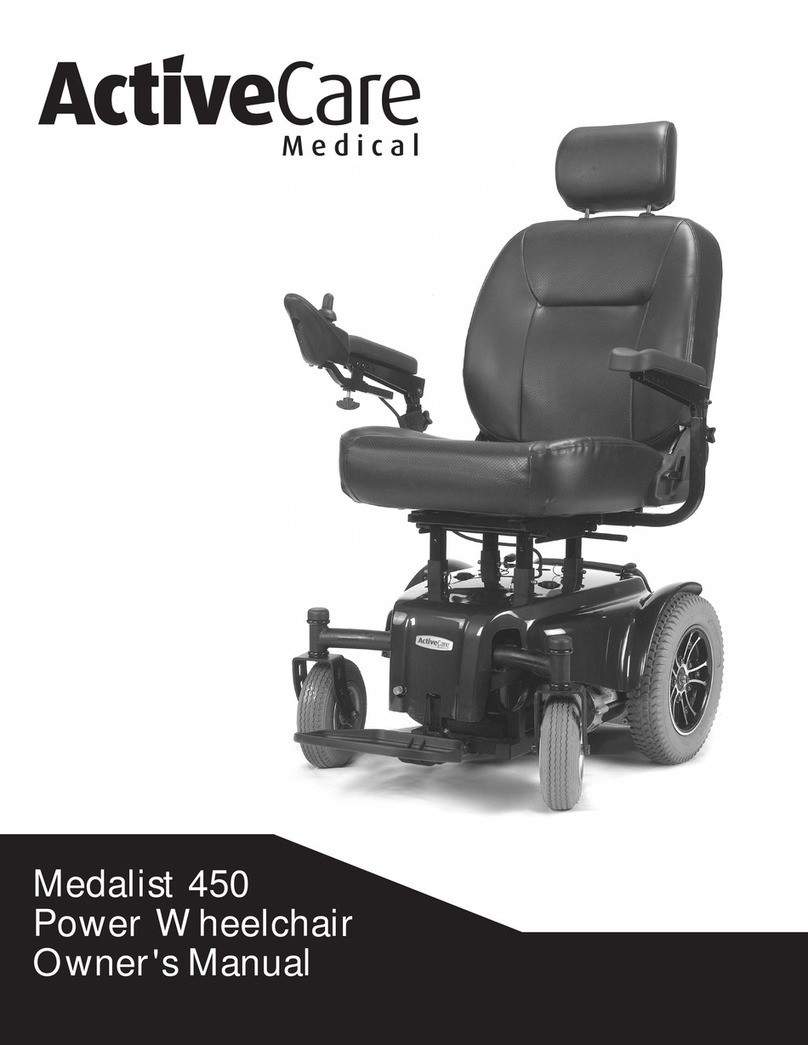
Active Care Medical
Active Care Medical Medalist 450 User manual
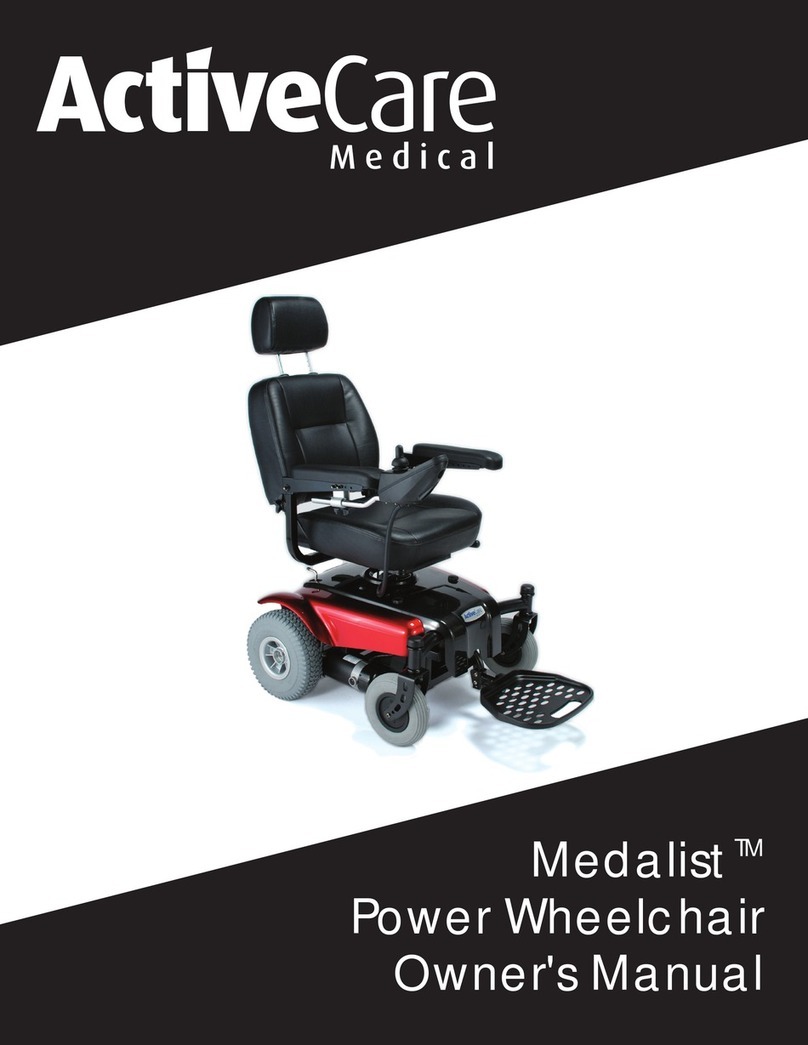
Active Care Medical
Active Care Medical medalist User manual
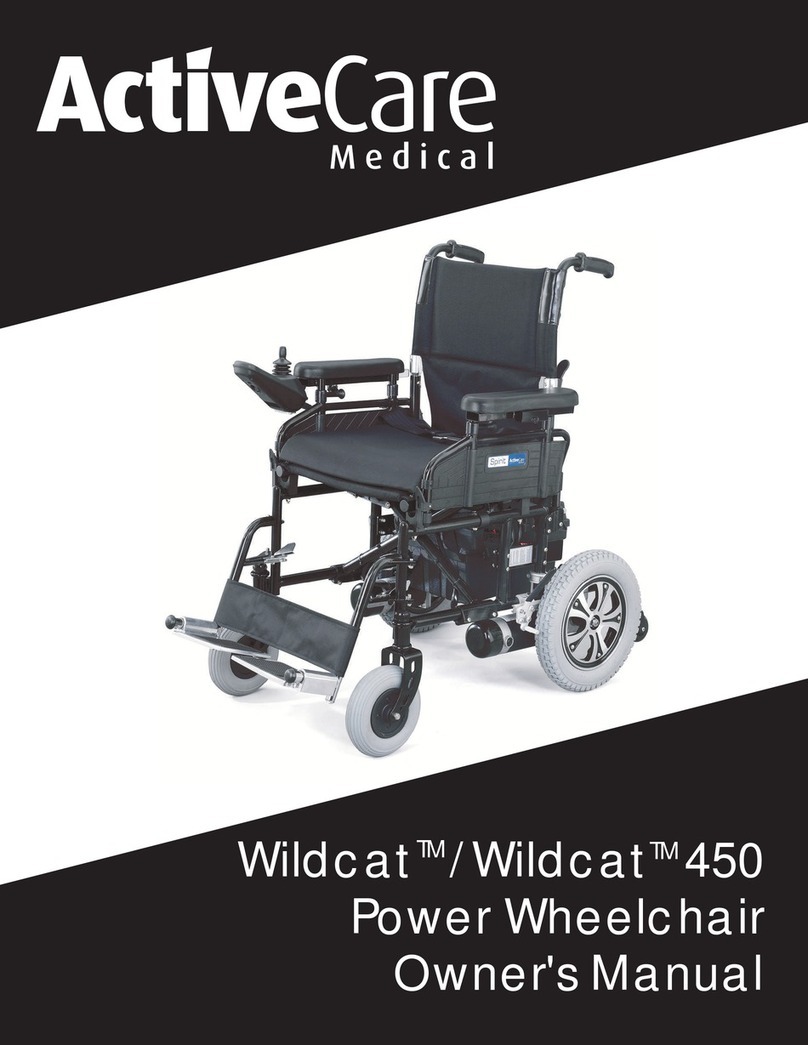
Active Care Medical
Active Care Medical Wildcat User manual
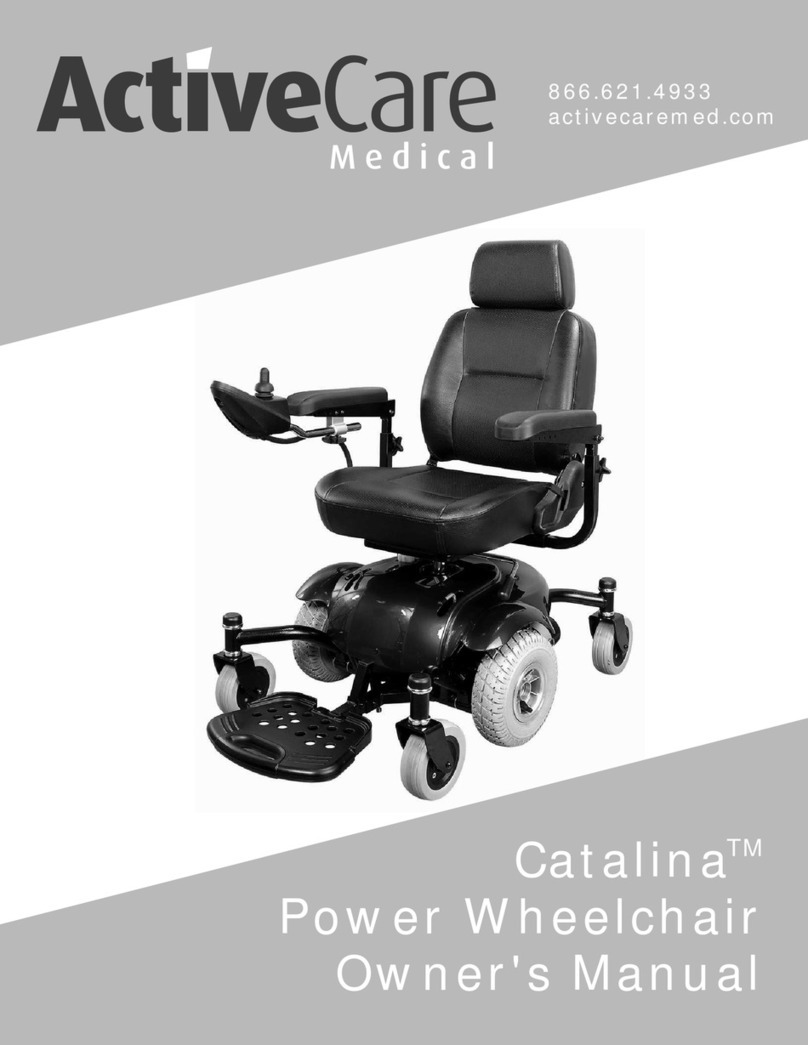
Active Care Medical
Active Care Medical Catalina User manual
